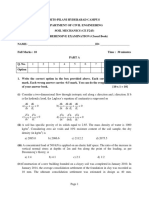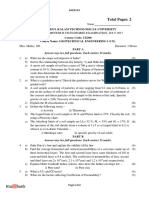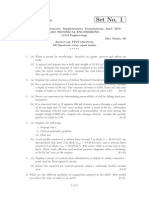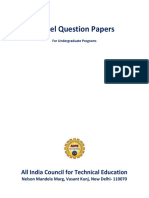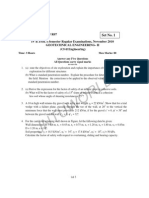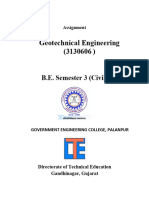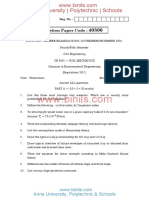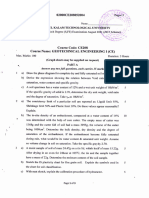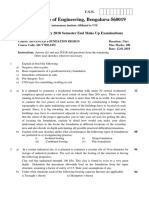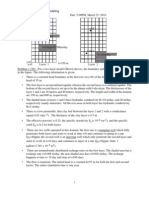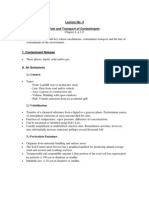Geotechnical Engineering 0001
Geotechnical Engineering 0001
Uploaded by
Mr DevilCopyright:
Available Formats
Geotechnical Engineering 0001
Geotechnical Engineering 0001
Uploaded by
Mr DevilCopyright
Available Formats
Share this document
Did you find this document useful?
Is this content inappropriate?
Copyright:
Available Formats
Geotechnical Engineering 0001
Geotechnical Engineering 0001
Uploaded by
Mr DevilCopyright:
Available Formats
Dr.
BABASAHEB AMBEDKAR TECHNOLOGICAL UNIVERSITY, LONERE
Supplementary Examination – Summer 2023
Course: B. Tech. Branch: Civil Engineering (11191) Semester: V
Subject Code & Name: CV503_18 Geotechnical Engineering
Max Marks: 60 Date:11/08/2023 Time: 2:00 to 5:00 PM
Instructions to the Students:
1. All the questions are compulsory.
2. The level of question/expected answer as per OBE or the Course Outcome (CO) on
which the question is based is mentioned in ( ) in front of the question.
3. Use of non-programmable scientific calculators is allowed.
4. Assume suitable data wherever necessary and mention it clearly.
(Level/ Marks
CO)
Q. 1 Solve any two of the following. 12
A) Define the terms ‘soil’, ‘soil mechanics’ and soil engineering. What are CO 1 06
limitations of soil engineering?
B) A sample of dry soil weighs 68 gm. Find the volume of voids if the total volume CO 1 06
of the sample is 40 ml and the specific gravity of solids is 2.65. Also determine
the voids ratio.
C) A soil has a porosity of 40 %, the specific gravity of solids of 2.65 and a water CO 1 06
content of 12 %. Determine the mass of water required to be added to 100 m3
of this soil for full saturation.
Q.2 Solve any two of the following. 12
A) What is relative density? How it is determined? What is the importance for CO 1 06
coarse-grained soil?
B) A sample of sand has a volume of 1000 ml in its natural state. Its minimum CO 1 06
volume when compacted is 840 ml. When gently poured in a measuring
cylinder, its maximum volume is 1370 ml. Determine the relative density.
C) The liquid limit and plastic limit of a clay are 100% and 25%, respectively. CO1 06
From a hydrometer analysis it has been found that the clay soil consists of 50%
of particles smaller than 0.002 mm. Indicate the activity classification of this
clay and the probable type of clay mineral.
Q. 3 Solve any two of the following. 12
A) Enlist and explain in detail the factors affecting permeability of soils. CO 2 06
B) Determine the average coefficient of permeability in the horizontal and vertical CO 2 6
directions for a deposit consisting of three layers of thickness 5 m, 1 m and 2.5
m and having the coefficients of permeability of 3 x 10-2 mm/sec, 3 x 10-5
mm/sec, and 4 x 10-2 mm/sec, respectively. Assume the layers are isotropic.
C) A glass cylinder 5 cm internal diameter and with a screen at the bottom was CO2 06
used as a falling head permeameter. The thickness of the sample was 10 cm.
With the water level in the tube at the start of the test as 50 cm above the tail
water, it dropped by 10 cm in one minute, the tail water level remaining
unchanged. Calculate the value of k for the sample of the soil. Comment on the
nature of the soil.
Q.4 Solve any two of the following. 12
A) Enlist the types of shear test based on drainage conditions & explain in detail. CO2 06
B) A series of direct shear tests was conducted on a soil, each test was carried out CO2 06
till the sample failed. The following results were obtained.
Sample Normal stress Shear stresses
No. (kN/m2) (kN//m2)
1 15 18
2 30 25
3 45 32
Determine the cohesion intercept and angle of shearing resistance.
C) The following results were obtained from a series of consolidated undrained CO2 06
tests on a soil, in which the pore water pressure was not determined.
Sample Confining pressure Deviator stress at
2
No. (kN/m ) failure (kN//m2)
1 100 600
2 200 750
3 300 850
Determine the cohesion intercept and angle of shearing resistance.
Q. 5 Solve any two of the following. 12
A) Enlist and explain in detail the factors affecting the compaction. CO 2 06
B) An earth embankment is compacted at a water content of 18% to a bulk density CO 2 06
of 19.2 kN/m3. If the specific gravity of the sand is 2.7, find the void ratio and
the degree of saturation of the compacted embankment.
C) A clay stratum 5 m thick has the initial void ratio of 1.50 and the effective CO 2 06
overburden pressure of 120 kN/m2. When the sample is subjected to an increase
of pressure of 120 kN//m2, the void ratio reduces to 1.44. Determine the
coefficient of the volume compressibility and the final settlement of the
stratum.
****** End ******
You might also like
- Radial Groundwater Flow of Confined and Unconfined Aquifer: By: Jake Nathaniel R. AbadDocument24 pagesRadial Groundwater Flow of Confined and Unconfined Aquifer: By: Jake Nathaniel R. AbadJake Nathaniel Abad100% (1)
- FE Exam Formatted ProblemsDocument12 pagesFE Exam Formatted ProblemsCarlo Galicia100% (1)
- Question Paper - Endsem - CE F243Document8 pagesQuestion Paper - Endsem - CE F243Vinayaka RamNo ratings yet
- Unconfined Aquifer With Uniform RechargeDocument4 pagesUnconfined Aquifer With Uniform RechargeHari Priya100% (1)
- Sardar Patel College of Engineering: 1. Question No. 1 Is Compulsory Attempt Any 4 Questions Out ofDocument29 pagesSardar Patel College of Engineering: 1. Question No. 1 Is Compulsory Attempt Any 4 Questions Out ofSudhir DeoreNo ratings yet
- 2 Geotechnical Engineering CE S4 B.Tech KTU 2017 PDFDocument2 pages2 Geotechnical Engineering CE S4 B.Tech KTU 2017 PDFJiji JosephNo ratings yet
- Geotechnical Engineering: Instructio Ns To CandidatesDocument2 pagesGeotechnical Engineering: Instructio Ns To CandidatesrajababushahNo ratings yet
- DSPDocument55 pagesDSPANUSHAMUNUPALLENo ratings yet
- 13A01602 Geotechnical Engineering - IDocument2 pages13A01602 Geotechnical Engineering - ILalith ReddyNo ratings yet
- Foundation EngineeringDocument1 pageFoundation EngineeringKya HaiNo ratings yet
- Foundation Engg - Tutorial (3160613) - GEC BHUJDocument8 pagesFoundation Engg - Tutorial (3160613) - GEC BHUJjalarampalanNo ratings yet
- Sanjay Ghodawat University, Kolhapur: InstructionsDocument2 pagesSanjay Ghodawat University, Kolhapur: InstructionsAmey KatdareNo ratings yet
- MQPDocument141 pagesMQPSheri Abhishek Reddy100% (1)
- 463III B.Tech II Semester Examinations, APRIL 2011 GEOTECHNICAL ENGINEERING-IDocument8 pages463III B.Tech II Semester Examinations, APRIL 2011 GEOTECHNICAL ENGINEERING-Isujan_duttaNo ratings yet
- C. Byregowda Institute of Technology - Kolar Department: Civil EngineeringDocument2 pagesC. Byregowda Institute of Technology - Kolar Department: Civil EngineeringNagendra GuptaNo ratings yet
- Foundational Engineering 3Document2 pagesFoundational Engineering 3sowmyanaidumoyyiNo ratings yet
- CE208 Geotechnical Engineering I, April 2018Document2 pagesCE208 Geotechnical Engineering I, April 2018Parvathy KNo ratings yet
- Gte Previous r07 PapersDocument12 pagesGte Previous r07 PapersyeswanthrNo ratings yet
- SMDocument2 pagesSMHrishikesh BhavsarNo ratings yet
- Btech Ce 5 Sem Geotechnical Kce501 2022Document2 pagesBtech Ce 5 Sem Geotechnical Kce501 2022ravi757092No ratings yet
- 18CV54Document4 pages18CV54yaligarumashankar89No ratings yet
- Concrete Technology (2)Document2 pagesConcrete Technology (2)vvsamarth82No ratings yet
- Concrete Technology SuplDocument4 pagesConcrete Technology Suplvvsamarth82No ratings yet
- Concrete Technology (3)Document2 pagesConcrete Technology (3)vvsamarth82No ratings yet
- CET 204 GEOTECHNICAL ENGINEERING-I MAY 2024Document3 pagesCET 204 GEOTECHNICAL ENGINEERING-I MAY 2024yadduuu17No ratings yet
- Sem - 1Document56 pagesSem - 1Supritha KNo ratings yet
- GE - Assignment (3130606)Document9 pagesGE - Assignment (3130606)arvindvanjara19No ratings yet
- NR 310105 GeotechnicalEngineeringDocument8 pagesNR 310105 GeotechnicalEngineeringSrinivasa Rao G100% (1)
- GE AssignmentsDocument9 pagesGE Assignmentsdaxchaudhary880No ratings yet
- CE504Document4 pagesCE504Mohasin KamalNo ratings yet
- Advanced Soil Mechanics s1 M.tech Ce Ktu 2016 Feb.Document3 pagesAdvanced Soil Mechanics s1 M.tech Ce Ktu 2016 Feb.Nirmal PanditNo ratings yet
- CE8491 Soil MechanicsDocument4 pagesCE8491 Soil MechanicsM.S ROOBININo ratings yet
- Mcegs 103 Advanced Soil MechanicsDocument4 pagesMcegs 103 Advanced Soil MechanicsTantai Rakthaijung100% (1)
- Ce208 Geotechnical Engineering I, August 2021Document3 pagesCe208 Geotechnical Engineering I, August 2021Parvathy KNo ratings yet
- Ce208 Geotechnical Engineering I, May 2023Document3 pagesCe208 Geotechnical Engineering I, May 2023Parvathy KNo ratings yet
- 21CV642Document2 pages21CV642Chandana JNo ratings yet
- Assnmt 11Document2 pagesAssnmt 11RK MEHTANo ratings yet
- 18CPC504 QPDocument2 pages18CPC504 QPZoroNo ratings yet
- Content Question Bank 111U07CE604Document3 pagesContent Question Bank 111U07CE604manisaibabaNo ratings yet
- Nov2017 Re-Exam FE 100%Document2 pagesNov2017 Re-Exam FE 100%kirtiNo ratings yet
- model question paperDocument1 pagemodel question papersharmasankalp108No ratings yet
- Geotechnical Engineering-I PDFDocument8 pagesGeotechnical Engineering-I PDFMopidevi Vijaya KishoreNo ratings yet
- Geotechnical Engineering: Chapter 1: Overview of Geotechnical Engineering Two Mark QuestionsDocument12 pagesGeotechnical Engineering: Chapter 1: Overview of Geotechnical Engineering Two Mark QuestionsSharvari DabirNo ratings yet
- 11CV7DEPADDocument2 pages11CV7DEPADHARNITH EVILLNo ratings yet
- BTCVC304CH3 1677128038 BTCVC304PS8 1674280457 QP Template B Tech W 22 FinalDocument2 pagesBTCVC304CH3 1677128038 BTCVC304PS8 1674280457 QP Template B Tech W 22 Final8gghbmss4rNo ratings yet
- Engineering ChemistryDocument2 pagesEngineering Chemistryraushanpathak464No ratings yet
- Fluid Mech (Civil) Exam - Sample - 1 - QuestionsDocument6 pagesFluid Mech (Civil) Exam - Sample - 1 - QuestionstracerkillerxsaNo ratings yet
- Enroll. No. Rajarambapu Institute of Technology, Rajaramnagar QP CodeDocument2 pagesEnroll. No. Rajarambapu Institute of Technology, Rajaramnagar QP CodekirtiNo ratings yet
- GE - W2022 (3130606) (GTURanker - Com)Document2 pagesGE - W2022 (3130606) (GTURanker - Com)kingmantragamingNo ratings yet
- 16CV7DEAFDDocument3 pages16CV7DEAFDHARNITH EVILLNo ratings yet
- GTCL 2016 Exam QuestionDocument3 pagesGTCL 2016 Exam QuestionKaosar Alam RockyNo ratings yet
- CE - 303 - GE - End Sem-1Document3 pagesCE - 303 - GE - End Sem-1Anudeep KumarNo ratings yet
- GT Dec13Document6 pagesGT Dec13Angelica KennedyNo ratings yet
- CET204 - Ktu QbankDocument10 pagesCET204 - Ktu QbankdipinnediyaparambathNo ratings yet
- UNITEC-geotechnical - Engineering - 2 - 5054 - 2012 - s2 AS ENGG 50Document11 pagesUNITEC-geotechnical - Engineering - 2 - 5054 - 2012 - s2 AS ENGG 50DonNo ratings yet
- Soil Mechanics1Document2 pagesSoil Mechanics1Birasa MallaNo ratings yet
- Department of Civil Engineering: Indian Institute of Technology Madras, ChennaiDocument2 pagesDepartment of Civil Engineering: Indian Institute of Technology Madras, ChennaiAnonymous Vx9KTkM8nNo ratings yet
- Final Exam Engineering GeologyDocument7 pagesFinal Exam Engineering GeologyBoos yousufNo ratings yet
- Exam SERIES 1Document2 pagesExam SERIES 1CJ ONLINENo ratings yet
- UCE501Document4 pagesUCE501Paarth SharmaNo ratings yet
- Geological Carbon Storage: Subsurface Seals and Caprock IntegrityFrom EverandGeological Carbon Storage: Subsurface Seals and Caprock IntegrityStéphanie VialleNo ratings yet
- Electrochemical Processes in Biological SystemsFrom EverandElectrochemical Processes in Biological SystemsAndrzej LewenstamNo ratings yet
- 3.-BTCVC603-CT-QB_updatedDocument3 pages3.-BTCVC603-CT-QB_updatedMr DevilNo ratings yet
- BTCVC 604 Project Management SolutionsDocument2 pagesBTCVC 604 Project Management SolutionsMr DevilNo ratings yet
- Mtcec102 Mtdcc102 SolutionDocument2 pagesMtcec102 Mtdcc102 SolutionMr DevilNo ratings yet
- Supple III-sem s24 GsDocument113 pagesSupple III-sem s24 GsMr DevilNo ratings yet
- 1749 2017 Summer Question PaperDocument4 pages1749 2017 Summer Question PaperMr DevilNo ratings yet
- PDF FileDocument2 pagesPDF FileMr DevilNo ratings yet
- Btech Civil 3 Sem Surveying 1 btchc304 Dec 2018Document2 pagesBtech Civil 3 Sem Surveying 1 btchc304 Dec 2018Mr DevilNo ratings yet
- DocScanner 10 Jan 2024 10 33 PMDocument10 pagesDocScanner 10 Jan 2024 10 33 PMMr DevilNo ratings yet
- Mane Saheb Slab Beam DetailsDocument1 pageMane Saheb Slab Beam DetailsMr DevilNo ratings yet
- TULJAI HOTEL PLAN MASKE SAHEBREVISED18.11.23-ModelDocument1 pageTULJAI HOTEL PLAN MASKE SAHEBREVISED18.11.23-ModelMr DevilNo ratings yet
- Multi-Level Slug Tests in Highly Permeable Formations: 1. Modification of The Springer-Gelhar (SG) ModelDocument12 pagesMulti-Level Slug Tests in Highly Permeable Formations: 1. Modification of The Springer-Gelhar (SG) ModelMaria F. SarmientoNo ratings yet
- Plate 4 Effective Stresses in Soil1pdf PDF FreeDocument17 pagesPlate 4 Effective Stresses in Soil1pdf PDF FreeDazai HirokiNo ratings yet
- Master Plan To GW Recharge 2020 - 2Document197 pagesMaster Plan To GW Recharge 2020 - 2Wrd Arunachal PradeshNo ratings yet
- Homework 2Document3 pagesHomework 2bigs1303No ratings yet
- Civil Engineering Licensure ExaminationsDocument7 pagesCivil Engineering Licensure ExaminationsvkenvynNo ratings yet
- General Tsadkan Complete ReportDocument21 pagesGeneral Tsadkan Complete ReportFisseha KebedeNo ratings yet
- Transpo QuizletDocument3 pagesTranspo QuizletArnold ApostolNo ratings yet
- Keysha Aditya Oksanto Faculty of Geological Engineering, Padjadjaran UniversityDocument5 pagesKeysha Aditya Oksanto Faculty of Geological Engineering, Padjadjaran UniversityKeysha Aditya OksantoNo ratings yet
- Method GeophysicsDocument68 pagesMethod GeophysicsAz SalehNo ratings yet
- Upstream Blanket SeepageDocument9 pagesUpstream Blanket Seepageahsanlatif91No ratings yet
- 13 GroundwaterDocument45 pages13 GroundwaterAsjad Ullah100% (1)
- Joint Inversion of Seismic Refraction and Resistivity Data Using Layered Models - Applications To Groundwater InvestigationDocument13 pagesJoint Inversion of Seismic Refraction and Resistivity Data Using Layered Models - Applications To Groundwater InvestigationDian Pratiwi MalikNo ratings yet
- Journal of Environmental & Earth Sciences - Vol.2, Iss.2 November 2020Document78 pagesJournal of Environmental & Earth Sciences - Vol.2, Iss.2 November 2020Bilingual PublishingNo ratings yet
- Test 07 Questions FinalDocument16 pagesTest 07 Questions Finalama kumarNo ratings yet
- Artificial Recharge of GroundwaterDocument6 pagesArtificial Recharge of GroundwaterDebasis DasguptaNo ratings yet
- Chapter 7Document49 pagesChapter 7daniellamirimbaNo ratings yet
- Gbrs IndepthDocument10 pagesGbrs Indepthstormwater.selmyNo ratings yet
- Lecture No. 4 Fate and Transport of ContaminantsDocument12 pagesLecture No. 4 Fate and Transport of ContaminantsJorn DoeNo ratings yet
- Ground Water HydraulicsDocument8 pagesGround Water HydraulicsMuhammad ismailNo ratings yet
- Soil Mechanics Chapter 4Document20 pagesSoil Mechanics Chapter 4Kc Kirsten Kimberly MalbunNo ratings yet
- Advanced LNAPL Kirkman 2013 MondayDocument25 pagesAdvanced LNAPL Kirkman 2013 MondayTEMA LITOCLEANNo ratings yet
- NZ 1999 Page 176-177Document436 pagesNZ 1999 Page 176-177Ald RinNo ratings yet
- Hydraulic Gradient of Soil Layers (BTP)Document2 pagesHydraulic Gradient of Soil Layers (BTP)sunilNo ratings yet
- Paper 1 FDMDocument19 pagesPaper 1 FDMAlbi HilalNo ratings yet
- Geotechnical Engineering and Hydraulics Final Coaching Nov 2018Document87 pagesGeotechnical Engineering and Hydraulics Final Coaching Nov 2018Jeremy Mark SorianoNo ratings yet
- BCV_bentonite_hydromechanical_behaviour_and_modellDocument20 pagesBCV_bentonite_hydromechanical_behaviour_and_modellplantengineer.ljcNo ratings yet


